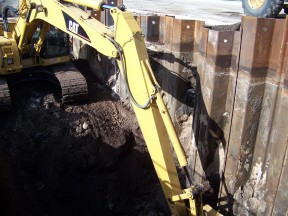Retaining Earth Structures, commonly referred to as retaining walls, are used to hold back earth and maintain a difference in the elevation of the ground surface.
Retaining walls are typically used in areas where site constraints are limited and slopes are not feasible, such as sea walls and overpasses. Generally the most common types of retaining walls include:
- Gravity
- Piling
- Cantilevered
- Anchored
- Sheet piles
MSE (Mechanically Stabilized Earthen) walls use structural members to withstand lateral pressures from retained soil and adjacent structures.
Retaining walls are typically constructed using concrete, masonry units, steel, timber, or composites. Gravity walls are normally constructed where access is not an issue. They are composed of a large mass of material that acts as a base and foundation. The base is very large and can withstand the lateral forces. Therefore, the mass of the material holds the structure in place with the downward force of gravity. A dam is a good example of a gravity wall.
Cantilevered retaining walls usually consist of a footer on either side of the wall in a profile view. A wall is tied in to the footer and constructed on top of the footer. The area is backfilled and the downward pressure on the footer essentially holds the wall in place. Sheet piles are constructed of steel and are normally a temporary solution. The piles are driven in to the ground and they interlock with one another. MSE walls can be constructed of several materials and are used when site constraints are the greatest. Normally panels are assembled in a line parallel to the earth needed to be retained. Each panel is tied into the earth behind the wall either in consecutive lifts or utilizing a nail procedure. FGE has experience with the geotechnical construction techniques to construct new retaining walls or repair existing retaining walls.
[blue_button link=”https://flgeotech.com/contact-us/”]Contact Us[/blue_button]

